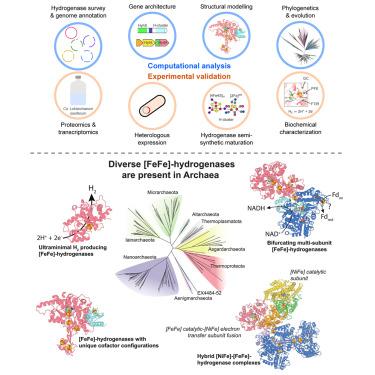Cell ( IF 45.5 ) Pub Date : 2024-06-11 , DOI: 10.1016/j.cell.2024.05.032 Chris Greening , Princess R. Cabotaje , Luis E. Valentin Alvarado , Pok Man Leung , Henrik Land , Thiago Rodrigues-Oliveira , Rafael I. Ponce-Toledo , Moritz Senger , Max A. Klamke , Michael Milton , Rachael Lappan , Susan Mullen , Jacob West-Roberts , Jie Mao , Jiangning Song , Marie Schoelmerich , Courtney W. Stairs , Christa Schleper , Rhys Grinter , Anja Spang , Jillian F. Banfield , Gustav Berggren

|
Microbial hydrogen (H2) cycling underpins the diversity and functionality of diverse anoxic ecosystems. Among the three evolutionarily distinct hydrogenase superfamilies responsible, [FeFe] hydrogenases were thought to be restricted to bacteria and eukaryotes. Here, we show that anaerobic archaea encode diverse, active, and ancient lineages of [FeFe] hydrogenases through combining analysis of existing and new genomes with extensive biochemical experiments. [FeFe] hydrogenases are encoded by genomes of nine archaeal phyla and expressed by H2-producing Asgard archaeon cultures. We report an ultraminimal hydrogenase in DPANN archaea that binds the catalytic H-cluster and produces H2. Moreover, we identify and characterize remarkable hybrid complexes formed through the fusion of [FeFe] and [NiFe] hydrogenases in ten other archaeal orders. Phylogenetic analysis and structural modeling suggest a deep evolutionary history of hybrid hydrogenases. These findings reveal new metabolic adaptations of archaea, streamlined H2 catalysts for biotechnological development, and a surprisingly intertwined evolutionary history between the two major H2-metabolizing enzymes.
中文翻译:

古细菌中的最小氢化酶和混合氢化酶具有活性
微生物氢 (H 2 ) 循环支撑着不同缺氧生态系统的多样性和功能。在三个进化上不同的氢化酶超家族中,[FeFe]氢化酶被认为仅限于细菌和真核生物。在这里,我们通过对现有和新基因组的分析与广泛的生化实验相结合,证明厌氧古菌编码多样化、活跃且古老的[FeFe]氢化酶谱系。 [FeFe]氢化酶由九个古菌门的基因组编码,并由产生 H 2 的 Asgard 古菌培养物表达。我们报道了 DPANN 古细菌中的一种超最小氢化酶,它结合催化 H 簇并产生 H 2 。此外,我们还鉴定并表征了其他 10 种古菌目中通过 [FeFe] 和 [NiFe] 氢化酶融合而形成的显着杂合复合物。系统发育分析和结构建模表明杂合氢化酶具有深厚的进化历史。这些发现揭示了古细菌新的代谢适应、生物技术发展的简化的 H 2 催化剂,以及两种主要的 H 2 代谢酶之间令人惊讶地交织在一起的进化历史。











































 京公网安备 11010802027423号
京公网安备 11010802027423号